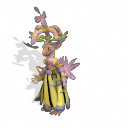
 Diet:
Diet: Omnivore
Danger Level: 9
Social Ability: 20
Observation: This is the first file I’ve come across that indicates an intelligent alien race. It was apparently deemed classified 70 years ago, and with my publication of this file will be the first public admission that there is life outside of our own!
According to this very thick file, this creature stands at an average height of 6 feet from head to toe. If you include the large feature protruding from the top, its height is close to 8 or 9 feet! The large, naturally formed head wear is composed of organic plants from which they draw solar energy from. This probably explains their rather slim figure, as their planet has two suns that light the surface. The second sun is a planet that is very close to the larger sun and is in the process of melting.

Both males and females have jewels embedded in their chest. While anatomically these jewels function as their heart, it also helps when they emote. It tend to change colors depending on their mood. It also helps identify gender. Males have a slightly blue hue, while females have a pink hue. To find a broken or shattered jewel on a creature means that it has experienced extreme heartbreak or stress, and creatures with a broken jewel die within the week in a very painful fashion. Or, at least, it is assumed that it is very painful, as those with broken jewels are seen crying uncontrollably until their deaths.
The race is very ritualistic in these matters of death. They will often come together as a community and make the dying as comfortable as possible. If they are able to achieve a smile from the dying member, the ritual is considered a success. They believe to die happy is a good death and you’ll be immediately ushered into paradise because of it. Again, this is implied, as there is a large red post-it note saying that the reporter made a false assumption based on their own religious creed.
Outside of the death rites, the race is also very social. They love to sing and dance. The most elaborate of these are reserved for the spring courtship season where they give into their primitive urges to mate and reproduce. Similar to peacocks on Earth, the males must put on an elaborate show in order to attract a mate. What’s interesting is that mating pairs are not strictly male-female pairings. Male-male couplings have been documented during the three-week-long season on more than one occasion. The race celebrates these pairings more than the traditional ones, mostly for their artistic displays if nothing else. When a male-female coupling does occur, the two are mates for life and not only produce the next generation, but pass on their skills in the arts as well.
They’ve developed their own hierarchy of art skill. While all are equally celebrated, many strive and often attempt to find a mate that is a member of the most desired art skill within the race: dance. Their native dance is similar to classical ballet at the most revered level, but it is clear that other genres of dance have been introduced into their culture. When throwing parties, which they do quite often, their dances resemble that found in contemporary rap music videos. The file calls describes them as "primitive gyration of the hip and buttock." Kind of hard to believe that an alien race essentially founded hip-hop before us Earthlings. Other dance genres this race has mastered include jazz, tap, swing, and ballroom dancing which is exclusively performed by male-female couples before conceiving their young.
Their native language consists of clicks, tweets, and croaks in a Mores Code like structure. Their singing ability, however, gives them the unique ability to mimic other languages that they believe is actually music instead of spoken words. However, learning a new language for them is a long process due to the fact that they treat it as if it is a new music genre.
It seems unfortunate that the person who discovered this creature has had their named blacked out by magic marker in the file. And being that it is dated from so long ago, I doubt anyone working here would know who originally reported this. A real shame, as this is one fascinating race of aliens to report about.
~Zeek Slider
 Diet: Herbivore
Diet: Herbivore
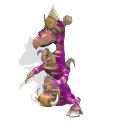
 Diet: Omnivore
Diet: Omnivore Diet: Omnivore
Diet: Omnivore Diet: Carnivore
Diet: Carnivore
 A monster of a creature if there ever was one!
A monster of a creature if there ever was one!
 Diet: Herbivore
Diet: Herbivore
 Diet: Carnivore
Diet: Carnivore
 Diet: Herbivore
Diet: Herbivore
 Diet: Omnivore
Diet: Omnivore
 Diet: Omnivore
Diet: Omnivore
 Diet: Herbivore
Diet: Herbivore
 Diet: Herbivore
Diet: Herbivore
 The senses of taste and touch are shared between all four heads. They don’t argue over the sense of touch so much as they do the sense of taste. Drawings from corpses indicate that they share the same stomach, but the pleasure of actually eating food has been observed to cause hour-long fights between the heads. If there is enough food for all four heads to enjoy, this kind of fight doesn’t happen.
The senses of taste and touch are shared between all four heads. They don’t argue over the sense of touch so much as they do the sense of taste. Drawings from corpses indicate that they share the same stomach, but the pleasure of actually eating food has been observed to cause hour-long fights between the heads. If there is enough food for all four heads to enjoy, this kind of fight doesn’t happen.
 Diet: Omnivore
Diet: Omnivore
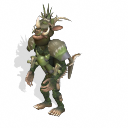
 Diet: Omnivore
Diet: Omnivore Diet: Herbivore
Diet: Herbivore
 Diet: Omnivore
Diet: Omnivore
 Diet: Herbivore
Diet: Herbivore
 During mating season, this creature will use a flower-like growth on its joints and tail to spread pheromones in the air to attract a mate. When a member of the opposite sex is met, the two will perform a dance. If their dances are in synchronous rhythm with each other, they are considered mates. If one of them is not in sync with the other, it is considered a bad match and the two go their separate ways. This mating behavior is possibly used to maintain the trick of looking like a sentient creature.
During mating season, this creature will use a flower-like growth on its joints and tail to spread pheromones in the air to attract a mate. When a member of the opposite sex is met, the two will perform a dance. If their dances are in synchronous rhythm with each other, they are considered mates. If one of them is not in sync with the other, it is considered a bad match and the two go their separate ways. This mating behavior is possibly used to maintain the trick of looking like a sentient creature.
 Diet: Omnivore
Diet: Omnivore Diet: Omnivore
Diet: Omnivore
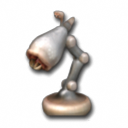 Diet: Omnivore
Diet: Omnivore Diet: Herbivore
Diet: Herbivore
 It has no forward-facing eyes of it own, but rather one compound eye on the back disguised as a crystal. This is designed to help it spot any predator that would stalk it from behind. Any predator that decides to attack from the front is spotted rather quickly. The large horn-shaped bulb on its chin acts in a similar fashion as the forehead of Earth dolphins by emitting sonar waves. Its ears are trained to pick up the ultra-sonic sound waves as they bounce off of objects. It also have a series of very sensitive feathered feelers which can pick up scents carried by the wind. This makes it almost impossible to stalk the creature, so cunning predators will resort to the element of surprise.
It has no forward-facing eyes of it own, but rather one compound eye on the back disguised as a crystal. This is designed to help it spot any predator that would stalk it from behind. Any predator that decides to attack from the front is spotted rather quickly. The large horn-shaped bulb on its chin acts in a similar fashion as the forehead of Earth dolphins by emitting sonar waves. Its ears are trained to pick up the ultra-sonic sound waves as they bounce off of objects. It also have a series of very sensitive feathered feelers which can pick up scents carried by the wind. This makes it almost impossible to stalk the creature, so cunning predators will resort to the element of surprise.
 Diet: Herbivore
Diet: Herbivore
 Most predators will try to attack its back, only to find that that they cannot break through the thick bone structure. Slightly smarter predators will notice the head is exposed and will try to attack that only to find that it has its own defenses. The nostril on its snout is a spitting gland that fires a sticky mucus that emits an odor when it is mixed with the oxygen and nitrogen in the air. This mucus doesn’t necessarily have to land on the predator in order for it to become a victim of its effects. The blast radius of the gland is able to cover the area surrounding this creature’s head. In order to not become a victim of its own defenses, it has evolved essentially a filtration system into its side nostrils. The mechanics of this system must be very specialized, as it takes the shape of soft flesh tubes located on either side of its snout.
Most predators will try to attack its back, only to find that that they cannot break through the thick bone structure. Slightly smarter predators will notice the head is exposed and will try to attack that only to find that it has its own defenses. The nostril on its snout is a spitting gland that fires a sticky mucus that emits an odor when it is mixed with the oxygen and nitrogen in the air. This mucus doesn’t necessarily have to land on the predator in order for it to become a victim of its effects. The blast radius of the gland is able to cover the area surrounding this creature’s head. In order to not become a victim of its own defenses, it has evolved essentially a filtration system into its side nostrils. The mechanics of this system must be very specialized, as it takes the shape of soft flesh tubes located on either side of its snout.
 Diet: Herbivore
Diet: Herbivore
 Diet: Omnivore
Diet: Omnivore
 Diet: Herbivore
Diet: Herbivore
 Diet: Omnivore
Diet: Omnivore
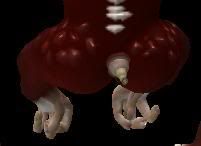 Another fascinating feature of this creature is a visible stink gland on its rear end. According to the file, this gland is similar to the one used by Earth skunks in that it used as a defensive weapon and emits a horrible smell. The actual liquid that is fired has acidic compounds that kill most organic matter almost immediately!
Another fascinating feature of this creature is a visible stink gland on its rear end. According to the file, this gland is similar to the one used by Earth skunks in that it used as a defensive weapon and emits a horrible smell. The actual liquid that is fired has acidic compounds that kill most organic matter almost immediately!
 Diet: Herbivore
Diet: Herbivore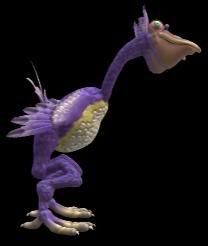 Its legs have an unusual configuration. It has four joints that form the letter S. On Earth, it is not uncommon to have animals with three joins in their legs, and they are able to walk just fine. It isn’t reported how this creature walks, but its unusual leg structure does give it a unique advantage in evading predators. The design gives it the ability to springboard into the air with amazing distance and speed. However, if not timed properly or of the predator is equally as good a jumper, the legs actually give the predator something to grab.
Its legs have an unusual configuration. It has four joints that form the letter S. On Earth, it is not uncommon to have animals with three joins in their legs, and they are able to walk just fine. It isn’t reported how this creature walks, but its unusual leg structure does give it a unique advantage in evading predators. The design gives it the ability to springboard into the air with amazing distance and speed. However, if not timed properly or of the predator is equally as good a jumper, the legs actually give the predator something to grab. Diet: Omnivore
Diet: Omnivore
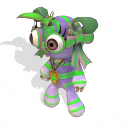
 Diet: Omnivore
Diet: Omnivore
 Diet: Omnivore
Diet: Omnivore Both males and females have jewels embedded in their chest. While anatomically these jewels function as their heart, it also helps when they emote. It tend to change colors depending on their mood. It also helps identify gender. Males have a slightly blue hue, while females have a pink hue. To find a broken or shattered jewel on a creature means that it has experienced extreme heartbreak or stress, and creatures with a broken jewel die within the week in a very painful fashion. Or, at least, it is assumed that it is very painful, as those with broken jewels are seen crying uncontrollably until their deaths.
Both males and females have jewels embedded in their chest. While anatomically these jewels function as their heart, it also helps when they emote. It tend to change colors depending on their mood. It also helps identify gender. Males have a slightly blue hue, while females have a pink hue. To find a broken or shattered jewel on a creature means that it has experienced extreme heartbreak or stress, and creatures with a broken jewel die within the week in a very painful fashion. Or, at least, it is assumed that it is very painful, as those with broken jewels are seen crying uncontrollably until their deaths. Diet: Carnivore
Diet: Carnivore
 An interesting anatomical feature of the Shinigami is naturally forming gauntlet on its hands. L reports that this gauntlet is formed from birth and only hardens as it grows. Newborn Shinigamis tend to break their wrists at least once, but juveniles are able to take blows to the forearms with no problem. Given how fragile their limbs appear to be, it makes sense that this creature would evolve some kind of protective element on one of its most powerful attack weapons. Its second powerful weapon is clearly the large claws on its feet. Combined with the wings on its back, this creature probably adopted an attack similar to the birds of prey we are familiar with. Because L reported that this creature doesn’t outright kill its prey, I have to hypothesize that the claws are the initial start of the attack, possibly to blind the prey, if it is a decent size or could potentially be a combative equal. Once on the ground, it then slashes with the claws on its natural gauntlet until its prey is disabled.
An interesting anatomical feature of the Shinigami is naturally forming gauntlet on its hands. L reports that this gauntlet is formed from birth and only hardens as it grows. Newborn Shinigamis tend to break their wrists at least once, but juveniles are able to take blows to the forearms with no problem. Given how fragile their limbs appear to be, it makes sense that this creature would evolve some kind of protective element on one of its most powerful attack weapons. Its second powerful weapon is clearly the large claws on its feet. Combined with the wings on its back, this creature probably adopted an attack similar to the birds of prey we are familiar with. Because L reported that this creature doesn’t outright kill its prey, I have to hypothesize that the claws are the initial start of the attack, possibly to blind the prey, if it is a decent size or could potentially be a combative equal. Once on the ground, it then slashes with the claws on its natural gauntlet until its prey is disabled.
 It has another part designed for attack: a flexible horn with a razor-sharp edge on the front. L’s report indicates only one observation in its use, and it’s a rather disturbing one. As a final act of mercy, L observed a juvenile Shinigami using the horn to behead its prey after eating the majority of the body. The young shinigami then proceeded to play with the head like a cat with a ball of yarn. Just reading that again makes me want to vomit. L hypothesizes that the adults probably do this as well, but none of his reports back indicate an opportunity to witness this.
It has another part designed for attack: a flexible horn with a razor-sharp edge on the front. L’s report indicates only one observation in its use, and it’s a rather disturbing one. As a final act of mercy, L observed a juvenile Shinigami using the horn to behead its prey after eating the majority of the body. The young shinigami then proceeded to play with the head like a cat with a ball of yarn. Just reading that again makes me want to vomit. L hypothesizes that the adults probably do this as well, but none of his reports back indicate an opportunity to witness this.
 Diet: Omnivore
Diet: Omnivore
 Another interesting oddity is a third eye that is strategically positioned on the back of its head. It also appears to be disguised as an antenna. According to the report, the eye stays closed unless the creature hears something that startles it. It will then open the third eye and scan the area. While scanning, the third eye ensures that no predator will advance on this creature while it is facing away. It also says in the report that should the creature feel unsafe, it will keep this third eye open as it walks! It must take amazing coordination to be able to walk forward while still being able to see what’s behind you. It would be like driving to work while still being able to look out the rear view mirror at the same time for the entire length of the trip!
Another interesting oddity is a third eye that is strategically positioned on the back of its head. It also appears to be disguised as an antenna. According to the report, the eye stays closed unless the creature hears something that startles it. It will then open the third eye and scan the area. While scanning, the third eye ensures that no predator will advance on this creature while it is facing away. It also says in the report that should the creature feel unsafe, it will keep this third eye open as it walks! It must take amazing coordination to be able to walk forward while still being able to see what’s behind you. It would be like driving to work while still being able to look out the rear view mirror at the same time for the entire length of the trip!
 Diet: Carnivore
Diet: Carnivore
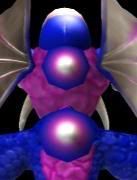 What limited knowledge I know about the evolutionary process, I would imagine that these two points on this creature’s body were constantly being attacked by predators. Possibly avian in nature since I seriously doubt anything on its planet that is a ground creature could reach it. When a generation evolved the other five false targets, the longevity of this creature increased. And because this was the design that gave it an advantage, Mother Nature let it keep it.
What limited knowledge I know about the evolutionary process, I would imagine that these two points on this creature’s body were constantly being attacked by predators. Possibly avian in nature since I seriously doubt anything on its planet that is a ground creature could reach it. When a generation evolved the other five false targets, the longevity of this creature increased. And because this was the design that gave it an advantage, Mother Nature let it keep it.
 Diet: Carnivore
Diet: Carnivore
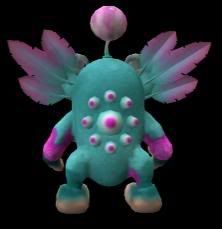 Another interesting observation is a strange bone formation on the back. It has eight dull boney humps circling a larger one in the center of its back. This person’s notes hypothesize that it may have something to do with the positioning of the sun or moon given how this creature sleeps at night. The configuration may be symmetrical, but points towards the position of either of these two celestial bodies. Because one was never captured, it was also hypothesized that this may be a way to determine gender. Using mythology and religion as a foundation, those that face the sun are thought to be male while those that face the moon are thought to be female.
Another interesting observation is a strange bone formation on the back. It has eight dull boney humps circling a larger one in the center of its back. This person’s notes hypothesize that it may have something to do with the positioning of the sun or moon given how this creature sleeps at night. The configuration may be symmetrical, but points towards the position of either of these two celestial bodies. Because one was never captured, it was also hypothesized that this may be a way to determine gender. Using mythology and religion as a foundation, those that face the sun are thought to be male while those that face the moon are thought to be female.